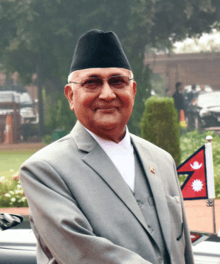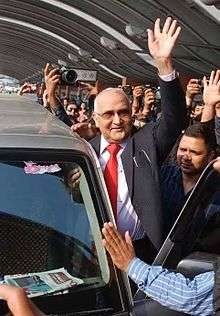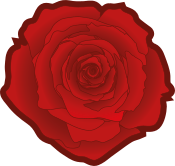KP Sharma Oli
Khadga Prasad Sharma Oli (Nepali: खड्गप्रसाद ओली, pronounced [kʰʌɖɡʌ ˈprʌsad̪ oli]; born 22 February 1952), more commonly known as K. P. Sharma Oli, is a Nepalese politician and the current Prime Minister of Nepal.[1][2][3] Oli previously served as prime minister from 11 October 2015 to 3 August 2016 and was the first elected prime minister under the newly adopted Constitution of Nepal.[4]
K. P. Sharma Oli | |
|---|---|
 | |
| 38th Prime Minister of Nepal | |
| Assumed office 15 February 2018 | |
| President | Bidhya Devi Bhandari |
| Preceded by | Sher Bahadur Deuba |
| In office 12 October 2015 – 4 August 2016 | |
| President | Ram Baran Yadav Bidhya Devi Bhandari |
| Preceded by | Sushil Koirala |
| Succeeded by | Pushpa Kamal Dahal |
| Chairman of the Nepal Communist Party | |
| Assumed office 17 May 2018 | |
| Preceded by | Position established |
| Minister of Foreign Affairs | |
| In office 2006–2007 | |
| Monarch | King Gyanendra |
| Prime Minister | Girija Prasad Koirala |
| Preceded by | Ramesh Nath Pandey |
| Succeeded by | Sahana Pradhan |
| Minister of Home Affairs | |
| In office 1994–1995 | |
| Monarch | King Birendra |
| Prime Minister | Manmohan Adhikari |
| Chairman of the Communist Party of Nepal (Unified Marxist–Leninist) | |
| In office 2014–2018 | |
| Preceded by | Jhala Nath Khanal |
| Succeeded by | Party dissolved (himself as chairman of the Nepal Communist Party) |
| Personal details | |
| Born | Khadga Prasad Sharma Oli 22 February 1952 Tehrathum, Nepal |
| Nationality | Nepalese |
| Political party | Nepal Communist Party |
| Other political affiliations | Communist Party of Nepal (UML) (before 2018) |
| Spouse(s) | Radhika Shakya |
| Parents | Mohan Prasad Oli (father) Madhumaya Oli (mother) |
| Website | kpsharmaoli |
Early life
Khadga Prasad Sharma Oli was born on 22 February 1952[5][6] in Aathrai, Tehrathum district of eastern Nepal. Born in a humble family of Kumai Brahmin farmers, he is the eldest child of Mohan Prasad and Madhumaya Oli.[7] Oli was raised by his grandmother, Rammaya, after his mother died of smallpox when he was four.[8] He completed his primary school education in Tehrathum and later migrated to the southeastern district of Jhapa in 1962.[9] He resided mostly in Jhapa during his early political life. Oli continued his studies upto Class 10 at Himalaya Higher Secondary School in Damak, Jhapa. He appeared in the School Leaving Certificate (SLC) exam but did not continue with further education.
Early political career

Oli began his political career in 1966 in opposition to the partyless Panchayat system in place at the time. He joined the Communist Party of Nepal in February 1970. He was involved in subversive politics and was arrested for the first time in 1970. A year later he became a district committee member of the party and soon the chief of the Jhapa Movement Organizing Committee in 1972. Oli was imprisoned for 14 consecutive years from 1973 to 1987 for being against autocratic Panchayat system. After his release from prison in 1987, he became a central committee member of Communist Party of Nepal (Unified Marxist–Leninist) and in-charge of the Lumbini zone until 1990.
Multi-party democracy (1991–2006)
After the 1990 People's Movement, he was elected as a member of parliament from Jhapa–6 in 1991. He held the post of chief of the foreign department of the CPN (UML) in 1992.
He was re-elected to parliament in 1994 and served as Minister of Home Affairs in Manmohan Adhikari's minority government. He was re-elected to the House of Representatives from Jhapa constituencies 2 and 6 in 1999 upon which he gave up his Jhapa–6 seat.
Transition period
Oli was appointed as deputy prime minister and Minister of Foreign Affairs as part of the interim government of Girija Prasad Koirala in 2006.[10][11] He was also assigned to look into the death of fellow politician Madan Bhandari.
He was defeated in the 2008 Constituent Assembly election from Jhapa–7. He also lost the election for the position of chairman to Jhala Nath Khanal during the eight general convention of CPN (UML) in 2009.
He was elected from Jhapa–7 in the 2013 Constituent Assembly election and became leader of the CPN (UML) parliamentary party on 4 February 2014, defeating party chairman Jhala Nath Khanal by a vote of 98 to 75.[12] Oli was subsequently elected as the chairman of CPN (UML) in July 2014 during the party's ninth general convention.[13][14]
First premiership
Oli was elected as Prime Minister in a parliamentary vote on 11 October 2015, receiving 338 votes out of 597. Oli's candidacy was supported by the Unified Communist Party of Nepal (Maoist), Rastriya Prajatantra Party Nepal, and Madhesi Jana Adhikar Forum along with 13 other small parties. He was sworn in on 12 October.[15]
His first stint was dominated by the economic blockade imposed by India upon the promulgation of the constitution of Nepal.[16] He took a defiant stance against India's position to amend the constitution and signed trade and transit treaties with China to counter Indian dependence.[17]
Following the withdrawal of support from the Communist Party of Nepal (Maoist Centre) on 13 July 2016 from the existing coalition government and subsequent registration of a no-confidence motion by the party on 14 July 2016, CPN (UML) and prime minister Oli seemingly shrank into a minority which pressured him to resign. But CPN (UML)'s decision to discuss the filed no-confidence motion led to a three-day parliament meeting of the concerned parties. During the process, two other major parties, Rastriya Prajatantra Party and Madhesi Jana Adhikar Forum, also removed their support from the coalition. On the third day, 24 July 2016, after addressing the opposition parties in parliament, Oli announced his resignation. The Indian government has been accused for creating this political scenario against Oli as he stood firmly against the economic blockade imposed by India.
Second premiership
Oli was appointed Prime Minister for a second time[18] on 15 February 2018 after CPN (UML) became the largest party in the House of Representatives following the 2017 legislative elections with support from Communist Party of Nepal (Maoist Centre), the same party whose withdrawal of support had led to resignation in his first term.[19] He passed a motion of confidence with on 11 March 2018 with 208 out of 268 votes in the 275-member House of Representatives.[20] He has been criticized for poor investigation in searching the murderers of Nirmala Panta leading to nationwide protests. In May 2020, the Oli government unveiled new maps of the country including the disputed territories of Kalapani, Lipulekh and Limpiyadhura in response to the inauguration of a road across the Lipulekh pass by the Indian government,[21] which has led to a "cartographic war" between the two countries.[22]
Electoral history
Oli has been elected to the Pratinidhi Sabha from Jhapa in 1991, 1994, 1999 and 2017 on a CPN (UML) ticket.[23] He contested and won from two constituencies in the 1999 election and gave up his Jhapa–6 seat. He lost the 2008 Constituent assembly election, but was elected in 2013. Only the top two candidates are shown below.
1991 Pratinidhi Sabha election
Jhapa–6
| Party | Candidate | Votes | Status |
|---|---|---|---|
| CPN (UML) | K.P. Sharma Oli | – | Elected |
1994 Pratinidhi Sabha election
Jhapa–6
| Party | Candidate | Votes | Status |
|---|---|---|---|
| CPN (UML) | K.P. Sharma Oli | 18,861 | Elected |
| Nepali Congress | Keshav Kumar Budhathoki | 14,202 | Lost |
1999 Pratinidhi Sabha election
Jhapa–2
| Party | Candidate | Votes | Status |
|---|---|---|---|
| CPN (UML) | K.P. Sharma Oli | 18,909 | Elected |
| Nepali Congress | Giriraj Kumari Prasai | 18,892 | Lost |
Jhapa–6
| Party | Candidate | Votes | Status |
|---|---|---|---|
| CPN (UML) | K.P. Sharma Oli | 23,749 | Elected |
| Nepali Congress | Kasi Lal Tajpuriya | 19,713 | Lost |
2008 Constituent Assembly election
Jhapa–7
| Party | Candidate | Votes | Status |
|---|---|---|---|
| Unified Communist Party of Nepal (Maoist) | Bishwodip Lingden Limbu | 16,099 | Elected |
| CPN (UML) | K.P. Sharma Oli | 14,959 | Lost |
2013 Constituent Assembly election
Jhapa–7
| Party | Candidate | Votes | Status |
|---|---|---|---|
| CPN (UML) | K.P. Sharma Oli | 19,287 | Elected |
| Nepali Congress | Suresh Kumar Youngaya | 11,041 | Lost |
2015 Parliamentary Prime Minister Election
| Party | Candidate | Votes | Status |
|---|---|---|---|
| CPN (UML) | K.P. Sharma Oli | 338 | Elected |
| Nepali Congress | Sushil Koirala | 249 | Lost |
2017 House of Representatives Election
Jhapa–5[24]
| Party | Candidate | Votes | Status |
|---|---|---|---|
| CPN (UML) | K.P. Sharma Oli | 57,139 | Elected |
| Nepali Congress | Khagendra Adhikari | 28,297 | Lost |
Personal life
Oli is married to Radhika Shakya. He met his wife, a fellow communist, after coming out of prison. They first met in the course of party activities and married later.[25]
Controversial claims
Oli is known for his tongue-in-cheek remarks and blithe disregard for his critics. He is popular for using various slang and proverbs (Nepali: उखान टुक्का, romanized: Ukhāna ṭukkā), suggesting double meanings and sometimes even to an extent of criticism from within his own party.[26][27] Having denied of hurting the sentiments of people, Oli has claimed that he learnt this technique during the Panchayat era to entertain his colleagues when he was underground.[27] Following are some of his controversial claims:
- Super computer, February 2019: Oli claimed that the world is amazed by the supercomputer being built by Nepal. He was referring to a computer that was being built in the Banepa IT Park, which the makers have claimed to be a supercomputer regardless of its limited computing capacity.[28]
- Indian coronavirus, May 2020: During the COVID-19 pandemic in Nepal, Oli had lashed out at India, saying that the “Indian virus” was more dangerous than the “Chinese or Italian virus” and even made light of the Indian national emblem.[29] He said this during an address to the parliament where he blamed the rising number of coronavirus cases on individuals breaking the nationwide lockdown, especially those sneaking into Nepal from India, claiming that "people coming from India through illegal channels are spreading the virus in the country."[30] This sparked a round of media attention in India.[31][32]
- Sneeze out the virus, June 2020: While adressing the National Assembly, Oli claimed, “...Corona is like the flu, if contracted, one should sneeze, drink hot water and drive the virus away...” generating ridicule in the national media and social networks. He also claimed ginger, garlic and turmeric are known to have vitamins and antioxidants that can help boost the immune system to fight coronavirus.[33]
- Lord Rama is a Nepali, July 2020: While addressing a function organised to mark the 207th birth anniversary of poet Bhanubhakta Acharya, Oli said Lord Rama was born in Nepal, that he was a Nepali, and that India had made cultural aggression by creating a ‘fake’ Ayodhya.[34][35][36] He claimed Thori, a place near Birgunj in southern Nepal to be the birthplace of Rama, and that it was nearly impossible for Rama to reach Janakpur in eastern Nepal to marry Sita from Ayodhya in India. He later ordered to investigate this matter officially, asking officials in the region to study about the whereabouts of Ayodhyapuri.[37] He also claimed to have found strong evidences in his claim of the 'real' Ayodhya, including ruins supposedly of Someshwar Gadhi and Valmiki Ashram, both associated with Lord Rama.[37]
See also
References
- "Oli appointed as 41st PM of Nepal". My Republica Online. Retrieved 15 February 2018.
- "KP Sharma Oli appointed Nepal's new prime minister". www.aljazeera.com. Retrieved 15 February 2018.
- "Oli as 41st PM of Nepal – Bolchha Nepal". Bolchha Nepal. 15 February 2018. Retrieved 15 February 2018.
- "Oli I elected 38th Prime Minister of Nepal (Update)". The Kathmandu Post. Retrieved 11 October 2015.
- "The Original Maoist". Nepali Times. Retrieved 13 December 2017.
- "KP Sharma Oli-why Nepal's new PM isn't the right man for the job". catchnews.com. Retrieved 13 December 2017.
- https://kpsharmaoli.com.np/index.php?/facetoface/detail/power-of-purpose-prime-minister-k-p-sharma-oli
- "Read a brief biography on newly elected PM KP Sharma Oli". The Kathmandu Post. Kantipur Publications. Retrieved 8 December 2017.
- Bharadwaj, Dr. Narad. "A Leader Who Stands Out From The Crowd". The Rising Nepal. Gorakhapatra. Retrieved 6 March 2020.
- "Nepal calls ceasefire with rebels". BBC. 3 May 2006. Retrieved 15 July 2012.
- Moriarty, James (2 May 2006). "Seven Cabinet Members Formed". Wikileaks. US Embassy, Kathmandu. Retrieved 21 September 2015.
- "Oli elected as UML PP leader". eKantipur. 4 February 2014. Archived from the original on 4 February 2014. Retrieved 4 February 2014.
- "The Himalayan Times: Oli elected UML chairman mixed results in other posts – Detail News: Nepal News Portal". The Himalayan Times. 15 July 2014. Retrieved 15 July 2014.
- "Nepal congratulates Oli for election victory". Myrepublica.com. 15 July 2014. Archived from the original on 18 July 2014. Retrieved 15 July 2014.
- "Nepal's new premier names protest group leaders as deputies", Associated Press, 12 October 2015.
- Sharma, Bhadra (24 July 2016). "Nepal's Prime Minister, K. P. Sharma Oli, Resigns Ahead of a No-Confidence Vote". The New York Times. Retrieved 16 February 2018.
- "Oli once more". Nepali Times. Himal Media Pvt Ltd. Retrieved 17 February 2018.
- "KP Oli becomes Prime Minister of Nepal for the second time". Kathmandu Tribune. Nepal Tribune Media. 15 February 2018. Retrieved 6 March 2018.
- Sharma, Gopal (15 February 2018). "Moderate Nepali communist Oli to 'balance China, India' as new PM". Reuters. Thomson Reuters. Retrieved 16 February 2018.
- "प्रधानमन्त्री ओलीका पक्षमा ७५ प्रतिशत सांसद". Setopati.com. Retrieved 12 November 2018.
- "Government unveils new political map including Kalapani, Lipulekh and Limpiyadhura inside Nepal borders". The Kathmandu Post. Retrieved 7 June 2020.
- "With release of new map, Nepal and India enter a state of 'cartographic war', experts say". The Kathmandu Post. Retrieved 7 June 2020.
- Election Commission of Nepal Archived 12 October 2006 at the Wayback Machine
- "Jhapa : Province 1 – Nepal Election Latest Updates and Result for Federal Parliament". The Kathmandu Post. Retrieved 10 December 2017.
- "Jeevan saathi with Mr & Mrs. K.P. Oli". YouTube. Himalaya TV. Retrieved 8 December 2017.
- "ओलीको उखान नियोजन". Retrieved 14 July 2020.
- "ओलीको नेतृत्वमा नयाँ सरकार : एमाले". SouryaOnline. Retrieved 14 July 2020.
- "प्रधानमन्त्रीको सुपर तुक्का". Shukrabar. Retrieved 14 July 2020.
- "Observers worry Oli's statements about an Indian conspiracy could further damage bilateral ties". kathmandupost.com. Retrieved 8 August 2020.
- "In three hours before Parliament, Oli presents problems but offers few solutions". kathmandupost.com. Retrieved 8 August 2020.
- "Indian coronavirus more lethal than Chinese: Nepal PM K P Sharma Oli". Retrieved 14 July 2020.
- "85% of people tested positive for coronavirus in Nepal are those who returned from India: PM Oli". The Hindu. Kathmandu. 10 June 2020. ISSN 0971-751X. Retrieved 1 August 2020.
- "Oli continues to downplay Covid-19 and propagate home remedies, earning ridicule on social media". Retrieved 14 July 2020.
- "Nepal's PM KP Sharma Oli 'claims' real Ayodhya is in Nepal". The Himalayan Times. 13 July 2020. Retrieved 14 July 2020.
- "Lord Rama is Nepali, not Indian, real Ayodhya in Nepal, claims PM KP Sharma Oli". Zee News. 14 July 2020. Retrieved 14 July 2020.
- "Editorial | Has Oli crossed Laxman Rekha?". kathmandupost.com. Retrieved 8 August 2020.
- Setopati, सेतोपाटी ::. "ठोरीको अयोध्यापुरीमा बढ्यो प्रम ओलीको चासो, आउँदो रामनवमीमा पूजा गरी काम सुरू गर्ने". Setopati. Retrieved 8 August 2020.CS1 maint: extra punctuation (link)
External links
| Party political offices | ||
|---|---|---|
| Preceded by Jhala Nath Khanal |
Leader of the CPN (UML) 2014–2018 |
Succeeded by Party dissolved |
| Preceded by New party formed |
Leader of the Nepal Communist Party (NCP) 2018–present |
Incumbent |
| Political offices | ||
| Preceded by Sushil Koirala |
Prime Minister of Nepal 2015–2016 |
Succeeded by Pushpa Kamal Dahal |
| Preceded by Sher Bahadur Deuba |
Prime Minister of Nepal 2018–present |
Incumbent |

